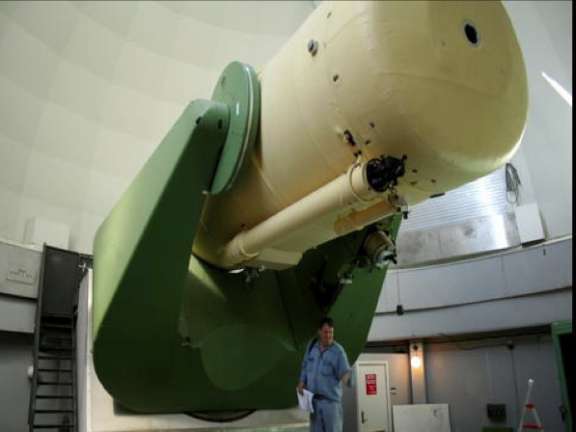Meg Schwamb • May 25, 2011
South of the Border
The last decade has seen an explosion in our understanding of the solar system with the discovery of the largest Kuiper belt objects (KBOs) of comparable size to Pluto. Each one of these objects; including Makemake, Pluto, Eris, Haumea, Sedna, Quaoar, and Orcus, has provided a wealth of information. Each of these large bodies tells a unique story, from Haumea's mantle-shattering collision to Sedna's lonely, strange orbit. These objects are the lighthouses of their population, bright enough for astronomers to discover them and study their physical properties and orbits using medium and large telescopes.

But the inventory of dwarf planets in the Kuiper belt is incomplete. All of the surveys that astronomers have ever conducted -- including Clyde Tombaugh's search, which led to his discovery of Pluto -- have been performed from telescopes in the northern hemisphere. We have covered the northern skies thoroughly and found the brightest bodies, including Eris, Pluto, Haumea, Quaoar, Makemake, Orcus, 2007 OR10 and Sedna. Although telescopes from the northern hemisphere can reach part of the southern sky, the southern hemisphere has remained virtually unexplored. The southern sky is the last unexplored frontier of the solar system. Perhaps one or two (or possibly zero) new dwarf planet-sized bodies await discovery. But we won't know if they're out there until we've looked, and that's why I've headed south. I'm not the only one; two other groups have also headed that direction too.
As a graduate student at Caltech with my thesis advisor Mike Brown and our collaborator David Rabinowitz at Yale University, I searched for distant objects beyond the Kuiper belt with orbits similar to Sedna, using the QUEST camera on the Samuel Oschin Telescope at Palomar Observatory. Our northern survey came to a close, and the QUEST camera was taken off the Oschin telescope. Then David Rabinowitz robotized the previously decommissioned 1.0-m Schmidt telescope at the European Southern Observatory (ESO) at La Silla, Chile. The telescope has been equipped with the QUEST camera (given a new life in Chile)
This equipment gave us the opportunity to conduct a survey to search for KBOs in the southern hemisphere. So after finishing graduate school and winning a National Science Foundation postdoctoral fellowship at Yale, I headed back to the east coast to be part of the La Silla-QUEST KBO survey, led by David Rabinowitz. The goal of our survey: to search the entire sky south of the ecliptic for large and bright KBOs out to distances of 100 astronomical units, more than three times farther out than the orbital distance of Neptune.
We look for KBOs each night that the Moon is not too bright. In order to find these icy planetoids, we take three images spaced several hours apart. We observe target fields near opposition. We choose to look near opposition because that exploits the relatively fast orbital motion of Earth to make the slow-moving KBOs appear to have retrograde (backwards) motion.
In a single image a KBO will appear to be a like a stationary star or galaxy in each one of our images, but when you look at the three images together, the KBOs will be the objects that appear to move from one image to the next. KBOs are extremely distant (30-100 AU) and so move very slowly (around one to three arcseconds per hour); this amounts to only a few pixels' worth of motion across our digital images.
Our survey observations are taken automatically by the telescope at night, and the images are sent to Yale each morning. Each morning, the first thing I do after I wake up is to check and see how the night went. Did our images go deep enough, or was it cloudy? Then I pick the fields we'll schedule for observation on the next night.
During the day, the "moving object pipeline" will remove the stationary background stars, search for moving objects, and link together what it thinks are moving KBOs. To confirm the presence of a moving solar system body, we crop snapshots from the discovery images centered around where the software thinks there is a moving object. Then we align and blink these snapshots by eye, more or less as Tombaugh did. If we can see a possibly real object moving across the three frames, we schedule further observations to confirm the discovery and help determine the KBO's orbit.
When the first surveys started looking for the brightest KBOs in the northern skies a little more than a decade ago, no one could predict what these discoveries would reveal. Studying the large dwarf planets has changed our perspective of the Kuiper belt and outer solar system. Perhaps there is something big or an object on a strange orbit lurking in the southern skies waiting to be found. Maybe it will yield exciting new results; I can't even attempt to speculate or imagine what they will be. That's why I'm looking. With a little luck and some clear skies perhaps we'll discover something new and interesting with La Silla-QUEST.

Support our core enterprises
Your support powers our mission to explore worlds, find life, and defend Earth. You make all the difference when you make a gift. Give today!
Donate

 Explore Worlds
Explore Worlds Find Life
Find Life Defend Earth
Defend Earth

